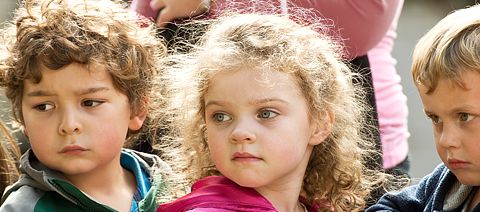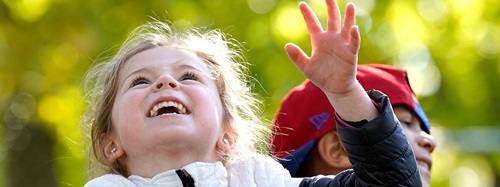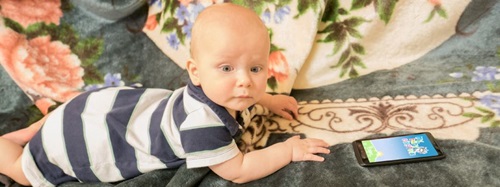Screening Out
Bringing Children Back from Virtual Worlds
|
September 2014
Children of the twenty-first century can navigate distant worlds from their video game controllers, but are not equipped with an understanding of the real world outside the window. Fascinating entertainment options have them hooked almost as soon as they can focus their eyes.
As parents and teachers, we know that too much technology is bad for children. And we’ve all heard horror stories about cyber-bullying, easily accessible porn sites, and online sexual predators. Parents can try to put controls on what their children can see and limit their access time. But what if the technology itself turns out to be bad for childhood?
Rhonda Gillespie is an infant and toddler specialist who has worked in early childhood education for decades. When I asked her what she thought about technology and children, she shared her own story:
I have seen a devastating impact on children over the last twenty years. Technology attacks the foundation necessary for healthy development.
When I was a child, our neighborhood was safe and I played outside every day with my friends. We used our creativity and imagination, enhanced our problem solving skills and developed healthy bodies. But by the time my son was growing up, I rarely saw neighborhood children playing outside. The trend had shifted, and the outdoors was perceived to be unsafe.
I had to return to work full time, which meant long days and less evening time to play and enjoy the outdoors with my son. The biggest mistake I made was purchasing him his first video game console. It started off with rules and time limits, but as time progressed, so did the hours at the game controller.
At the beginning, it seemed like a win-win: he was interacting with children from all over the world and could casually socialize with his age group. He became good at some games and his confidence rose. I always thought that at some point he would find friends to play with in the neighborhood. Socialization has always been a challenge for him, and video game companies often bill their products as a bridge to forming connections. Now I feel he was denied the chance to develop healthy interactions.
My son is seventeen years old now. He will text all day long, but when he’s around people, he does not know what to say or how to start a conversation. He says he is comfortable talking to people on the computer because he does not get bullied. But the flip side is that he did not learn to work through those awkward childhood moments that are an opportunity for growth. If he had never had the choice of online “friends,” would he have learned better social skills?
Part of childhood is about problem solving, working out strategies and solutions to everyday life issues. Life became easier with technology, but it also made children unfamiliar with the process of success: hard work and patience. We have created a generation that expects things immediately without effort. For example, when I was in school I would spend months on a research paper, taking many trips to the library, spending hours studying and collecting verified data. My son can now produce the same report in a few hours, on his computer, without the element of verification or proof.
The accessibility of screen devices has caused a significant decline in children’s resilience, self-determination, desire for hard work, and sense of pride in achievement. And socialization among children is becoming extinct.
Technology affects people of all ages, simply because it transfers our interest and consideration from human beings to machines. It’s especially damaging for young children, who used to rely on the adults close to them for guidance and example. In his book, Simplicity Parenting, educator Kim John Payne touches on this point:
The late MIT professor and pioneer of artificial intelligence Joseph Weizenbaum came to wonder about the appropriateness of computer technology for young children. He questioned whether we want to expose our young children to artificial minds without human values or even common sense. Weizenbaum believed that there are transcendent qualities of human interaction that can never be duplicated by machines; he used as an example “the wordless glance that a father and mother share over the bed of their sleeping child.”
Used too soon, does the two-dimensional screen of a computer actually interfere with a young child’s complex learning systems of relationships and sensory exploration? I don’t believe that computers should be a part of a young child’s daily life. How curious will children be, how mentally agile, creative, and persistent in seeking answers to their questions, if, from a young age, they learn to Google first, and ask questions later (or not at all)?
There is no easy way to relieve the burden that technology places on children. But if we love them, we can’t slip into resignation just because we don’t know where to start. One way to take action is to give children more “white space.” In a book, white space is the room between the lines of type, the margins, the extra space at the beginning of a chapter. It allows the type to “breathe” and gives the eye a place to rest. White space is not something you’re conscious of when you read a book. It is what isn’t there. But if it were gone, you’d notice it right away. It is the key to a well-designed page.
Just as books require white space, so do children. They need room to grow, in a space shielded from the onslaught of the information age. It does not take a brilliant mind to see the effects of a lack of white space. When children are overwhelmed by entertainment, material goods, high pressure academics, and frequently unstable home life, it’s as if their flashlight batteries are being run down. Their light gets dimmer, and they don’t know what’s wrong. If we deny them the time, space, and flexibility they need to develop at their own pace, they will not be able to recharge their batteries.
The ancient Chinese philosopher Lao-Tzu reminds us that “it is not the clay the potter throws that gives the jar its usefulness, but the space within.” If stimulation and guidance are the clay, then time by oneself is the space within. Hours spent alone in daydreams or in quiet, unstructured activities—preferably out in nature—instill a sense of security and independence and provide a necessary lull in the rhythm of the day. Children thrive on silence. Without external distractions they will often become so inspired by what they are doing that they will be totally oblivious of everything around them. Unfortunately, silence is such a luxury that they are rarely allowed the opportunity for such undisturbed concentration.
As parents and caregivers, how can we find creative ways to give children more silence and space?
We don’t all live as close to forests and streams as we might wish. But creative teachers can do a lot with a little. Dana Wiser, a friend of mine, remembers how his daughter’s teacher found a way to give her students white space during the day:
When my daughter Mary was in first grade, she was lucky to have a teacher wise in the ways of both children and nature. She encouraged every child to adopt one of the trees that were grouped around the children’s playground. Mary’s “pet tree” was a sycamore, strong and tall, and of a girth she could hide behind. Each child studied the adopted tree, tracing its leaves and bark pattern. Quiet time spent with their pet trees was extra special, and when something about the school day upset Mary, all she had to do was visit her sycamore, drawing solace from its strength and comfort from its shade. She will love all trees, and especially sycamores, all her life; more than that, something of nature’s healing power lives in her heart as a gift from her pet tree.
Looking for more stories of creative ways to give children time and space in a media-saturated society? Request a free copy of Their Name Is Today
© Plough Publishing House 2014; used with permission.






